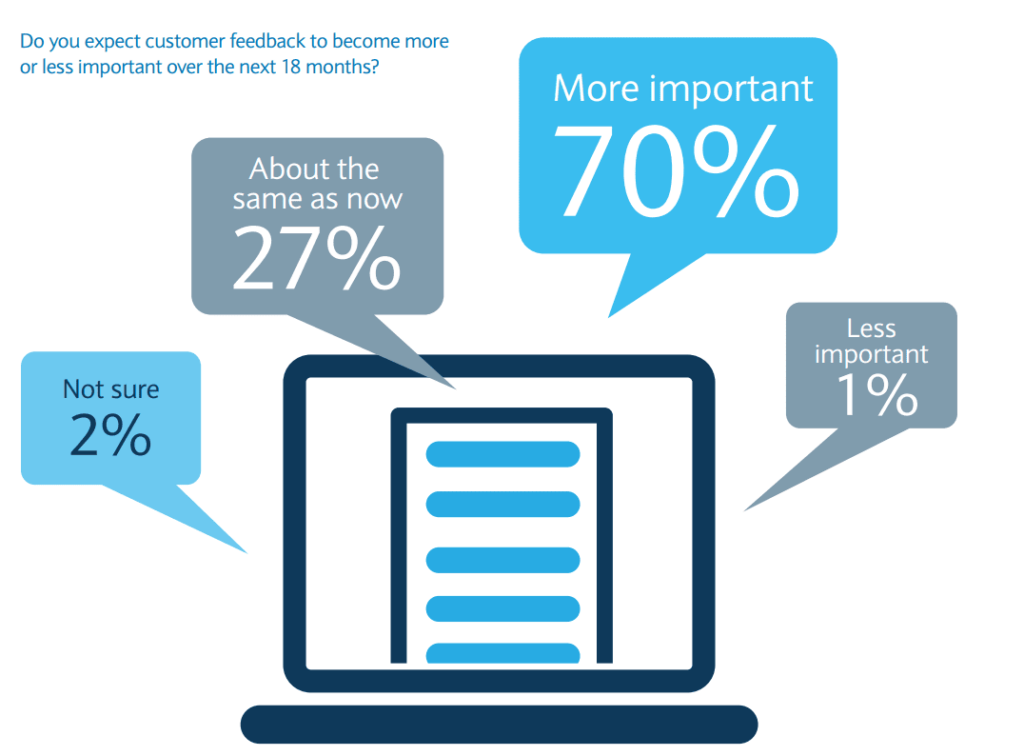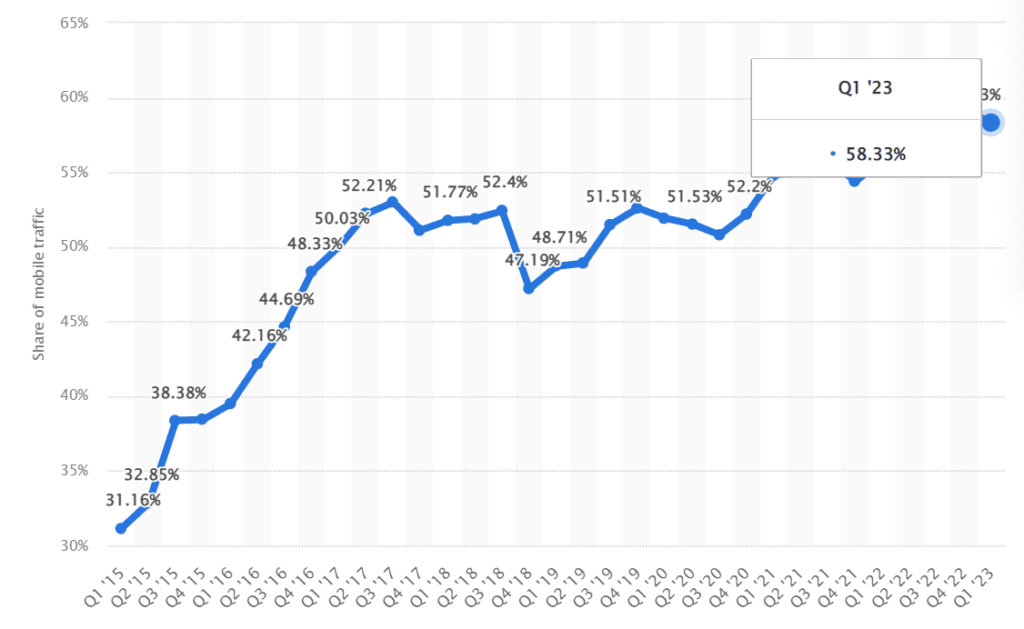Designing Effective Feedback Surveys for E-commerce: 7 Best Practices and Tips

In the fast-paced realm of eCommerce, businesses constantly strive to enhance their customers’ experiences and build lasting relationships. To accomplish this, feedback surveys are an indispensable tool for understanding customer needs, identifying areas for improvement, and staying ahead of the competition.
Feedback surveys serve as a crucial bridge between eCommerce businesses and their customer base, offering insights that drive growth, innovation, and success. According to Barclays, about 70% of SMEs feel that online customer feedback will become more important & 27% think it’ll remain the same.

Designing effective feedback surveys is an art in itself. It requires careful planning and a deep understanding of the customer journey. When crafted skillfully, these surveys become powerful instruments for gathering actionable data that ultimately elevates the customer experience.
This article will explore the best practices and tips to help your eCommerce business create effective feedback surveys that yield meaningful results.
So, let’s begin without any delay.
Chapters
- 7 Best Practices and Tips for Designing Effective E-commerce Feedback Surveys
- 1. Defining Clear Goals and Objectives
- 2. Crafting Concise and Relevant Questions
- 3. Utilizing the Right Question Types
- 4. Give a Clear Estimated Time to Complete the Survey
- 5. Implementing Logical Flow and Structure
- 6. Providing Clear Instructions and Context
- 7. Embracing Mobile-friendly Designs
- Conclusion
- FAQ
7 Best Practices and Tips for Designing Effective E-commerce Feedback Surveys

Here are some tips and best practices to get started with designing feedback surveys that boost user experience of your eCommerce site.
1. Defining Clear Goals and Objectives
Defining clear goals and objectives for your feedback survey is a crucial first step in designing an effective survey. Without a clear purpose, the survey may lack direction, resulting in vague or irrelevant questions that fail to provide meaningful insights.
Here are some key points to consider when defining the goals and objectives of your survey:
- Identify the purpose or specific reason for conducting the survey. Do you want to measure customer satisfaction, want to get feedback to improve your product marketing, evaluate a particular aspect of your eCommerce, or explore potential areas for improvement?
- Your objectives should be specific and measurable, allowing you to track progress and assess the effectiveness of your survey efforts.
- Determine the specific aspects or areas you want to explore in your survey.
- Set realistic and achievable goals for your survey. Consider factors such as the time and resources available, the size of your customer base, and the frequency of survey administration.
2. Crafting Concise and Relevant Questions
The effectiveness of a feedback survey relies heavily on the quality of its questions. Thus, it’s essential to ensure that your questions are concise, easy to understand, and relevant to the survey’s purpose.
Avoiding jargon and technical terms, while maintaining a conversational tone, will encourage respondents to provide accurate and insightful feedback. Moreover, ensure that each question focuses on one idea or topic to avoid ambiguity.
By following these guidelines, you can ensure that your survey accurately captures the information you need, allowing you to gain valuable insights and make informed decisions for your eCommerce business. See how an AI Survey Question Generator can help you come up with effective questions.
3. Utilizing the Right Question Types

Choosing the appropriate question types enhances survey engagement and generates more meaningful responses. Whether it’s multiple-choice, rating scales, open-ended questions, or a combination, selecting the right question format facilitates data analysis.
Multiple-choice questions are effective for gathering quantitative data. Rating scale questions help in the measurement of user attitudes, perceptions, or satisfaction levels. Open-ended questions allow respondents to provide detailed and unrestricted responses in their own words.
All of them are valuable for capturing qualitative data, uncovering insights, and understanding the reasons behind certain opinions or experiences. By utilizing the right question types in your survey, you can effectively capture the data needed for your eCommerce business.
4. Give a Clear Estimated Time to Complete the Survey
Providing a clear estimation is essential for managing respondents’ expectations and ensuring higher participation rates. When your respondents have a clear understanding of the time commitment involved, they are more likely to complete the survey willingly and provide thoughtful responses.
Being transparent about this aspect fosters a positive perception of your survey and encourages respondents to engage with it. Further, estimating the survey completion time helps you plan and manage your survey project effectively. You can allocate resources, set realistic timelines, and anticipate the time required for data analysis.
This demonstrates respect for respondents’ time, encourages higher participation rates, and contributes to a positive eCommerce feedback survey experience.
5. Implementing Logical Flow and Structure
The flow and structure of your feedback survey should be intuitive and logical. Your eCommerce survey should have questions in an organized way that guides respondents through a seamless journey, from general inquiries to more specific ones.
Begin your survey with a clear introduction that explains the purpose of the survey and provides any necessary context. Additionally, grouping related questions and incorporating logical transitions will enhance the overall survey experience and yield comprehensive data.
Another best practice is to incorporate a progress indicator bar that shows respondents how far they are in the survey. Also, keep in mind to arrange your questions in a logical order that makes sense to respondents.
By implementing these practices, you create a user-friendly feedback survey that respondents are likely to complete.
6. Providing Clear Instructions and Context
When presenting a feedback survey to customers, it is crucial to provide them with clear instructions and relevant context. Explain the purpose of the survey, assure respondents of data confidentiality, and highlight the importance of their input.
If certain questions in your survey require additional context or explanation, include specific instructions for those questions. Moreover, if you are using scales or response formats, provide clear guidance on how respondents should interpret and use them.
Clearly communicating such things increases trust and the likelihood of receiving genuine, thoughtful responses. It also enhances the quality and accuracy of the responses, leading to valuable insights for your eCommerce business.
7. Embracing Mobile-friendly Designs
In the first quarter of 2023, over 58% of the website traffic worldwide comes from mobile devices.

With this increasing dominance of mobile devices, designing surveys that are optimized for mobile use has become a necessity. To ensure your surveys are mobile-friendly, use responsive designs that adapt seamlessly to different screen sizes.
Further, reduce unnecessary clutter and use a clean, intuitive design on various mobile screens. Also, ensure that survey elements such as buttons and response options are designed with touch-friendly sizes.
This approach enables customers to participate conveniently, leading to higher response rates and a more representative dataset.
Conclusion
By adhering to these best practices, eCommerce businesses can unlock the potential of feedback surveys for customer-centric decision-making. Through comprehensive data collection, thoughtful analysis, and timely action, these surveys serve as the cornerstone of a successful eCommerce strategy.
Understand that designing effective feedback surveys is an ongoing process that requires continuous evaluation and refinement. By consistently striving for excellence in survey design, you can build stronger relationships with your customers, enhance their experience, and drive success in the competitive landscape.
Author
 Chirag Bhavsar is founder of Coduzion. A Gusty, Passionate, and a Sports freak. Loves to spend time reading financial books and playing outdoor games as soon as he is away from his desk. He always loves to take on new challenges and get good at them.
Chirag Bhavsar is founder of Coduzion. A Gusty, Passionate, and a Sports freak. Loves to spend time reading financial books and playing outdoor games as soon as he is away from his desk. He always loves to take on new challenges and get good at them.
FAQ
What are feedback surveys in e-commerce?
Feedback surveys in e-commerce are questionnaires or forms sent to customers to gather their opinions, feedback, and insights about their shopping experiences and the online store.
Why are feedback surveys important for e-commerce businesses?
Feedback surveys help e-commerce businesses understand customer preferences, identify areas for improvement, enhance customer satisfaction, and make informed decisions.
How can e-commerce businesses distribute feedback surveys to customers?
Feedback surveys can be distributed through email, on the website, via social media, or through post-purchase pop-up forms.
What types of questions should e-commerce businesses include in their feedback surveys?
Questions may cover product quality, website usability, shipping experience, customer service, and overall satisfaction.
When is the best time to send feedback surveys to e-commerce customers?
Feedback surveys can be sent post-purchase, after a customer support interaction, or at specific touchpoints in the customer journey.
How can e-commerce businesses incentivize customers to complete feedback surveys?
Offering discounts, entry into a contest, or exclusive content can incentivize customers to participate in surveys.
What should e-commerce businesses do with the feedback collected from surveys?
E-commerce businesses should analyze feedback, identify trends, prioritize improvements, and communicate changes to customers when appropriate.
Are there tools and software available to help e-commerce businesses create and manage feedback surveys?
Yes, tools like SurveyMonkey, Google Forms, and dedicated survey platforms can assist in creating and analyzing feedback surveys.
How can e-commerce businesses ensure the privacy and security of customer feedback data?
E-commerce businesses must follow data protection regulations and secure survey data through encryption and secure storage.
What are some best practices for e-commerce feedback surveys to maximize response rates and quality of feedback?
Best practices include keeping surveys concise, using a mix of question types, testing surveys before deployment, and being transparent about the purpose of the survey.
Can e-commerce businesses use feedback surveys to measure customer loyalty and retention?
Yes, feedback surveys can include questions to gauge customer loyalty, such as Net Promoter Score (NPS) questions.
What is the typical response rate for e-commerce feedback surveys, and how can businesses improve it?
Response rates can vary, but businesses can improve them by keeping surveys concise, using engaging language, and offering incentives.
Are there industry-specific feedback survey templates available for e-commerce businesses?
Yes, some survey platforms provide industry-specific templates tailored for e-commerce businesses.
How can e-commerce businesses analyze and interpret feedback survey data effectively?
Utilizing data analysis tools, categorizing feedback themes, and creating actionable insights are key to effective analysis.
Can feedback surveys help e-commerce businesses identify and address issues with product returns and refunds?
Yes, feedback surveys can gather input on the returns and refunds process, helping businesses improve customer satisfaction in this area.
Are there strategies for following up with customers after they complete feedback surveys?
E-commerce businesses can follow up with customers to thank them for their feedback and provide updates on actions taken based on the survey results.
How can businesses ensure that feedback surveys remain unbiased and impartial?
Crafting neutral and unbiased questions, avoiding leading language, and randomizing question order can help maintain survey impartiality.
Can e-commerce businesses use feedback surveys to gather testimonials and reviews for their products and services?
Yes, feedback surveys can include questions inviting customers to share testimonials and reviews.
What role does feedback survey data play in improving the overall customer experience for e-commerce shoppers?
Feedback survey data informs changes and enhancements to the customer journey, leading to an improved overall experience.
Are there regulatory compliance considerations when collecting and storing feedback survey data for e-commerce businesses?
E-commerce businesses must comply with data protection regulations like GDPR or CCPA when collecting and storing survey data.
How can e-commerce businesses use feedback surveys to identify potential areas for product expansion or diversification?
Feedback surveys can include questions about product preferences and suggestions, providing insights into potential expansion opportunities.
Are there strategies to encourage customers to provide detailed and constructive feedback in surveys?
Encouraging open-ended responses, asking for specific examples, and ensuring anonymity can lead to more detailed and constructive feedback.
Can e-commerce businesses segment their feedback surveys for different customer demographics or purchase history?
Yes, businesses can customize surveys for specific customer segments to gather targeted insights based on demographics or past behavior.
How can e-commerce businesses effectively act on feedback survey results to drive business growth?
Actionable steps include prioritizing improvements, implementing changes, and monitoring the impact on customer satisfaction and business growth.
Are there strategies to prevent survey fatigue among frequent customers or subscribers?
Limiting survey frequency, keeping surveys short, and using occasional incentives can help prevent survey fatigue.
Can e-commerce businesses integrate feedback survey data with their CRM (Customer Relationship Management) systems?
Yes, integration with CRM systems allows businesses to combine survey data with customer profiles for more personalized interactions.
How can businesses maintain a balance between soliciting feedback and not overwhelming customers with survey requests?
Implementing a well-thought-out feedback strategy, timing requests appropriately, and using customer preferences can help maintain this balance.
Are there benchmark metrics that e-commerce businesses should track when analyzing feedback survey data?
Benchmark metrics like Customer Satisfaction Score (CSAT), Net Promoter Score (NPS), and Customer Effort Score (CES) provide valuable insights.
What are the benefits of sharing feedback survey results with employees and stakeholders within an e-commerce business?
Sharing results fosters a customer-centric culture, motivates employees, and encourages collective efforts to enhance customer satisfaction.
Can e-commerce businesses use feedback surveys to stay ahead of competitors and adapt to changing market trends?
Yes, feedback surveys can reveal emerging trends and customer expectations, enabling businesses to stay competitive and agile.
Create more and better content
Check out the following resources and Grow!